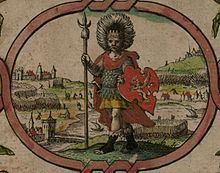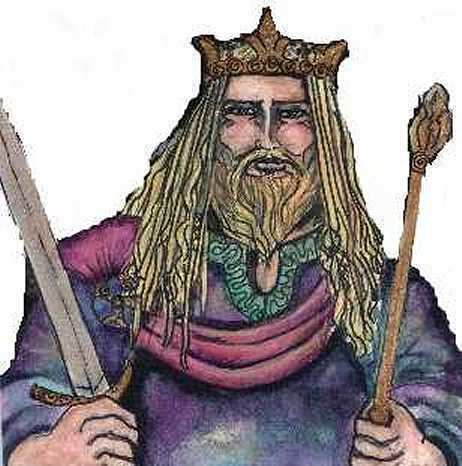Reign 519–534 Name Cerdic Wessex Children Cynric of Wessex Issue Cynric | Successor Cynric Died 534 AD Predecessor None Role King | |
 | ||
Great grandchildren Cuthwine of Wessex, Cynegils of Wessex Similar People Cynric of Wessex, Egbert of Wessex, AEthelred of Wessex, AEthelwulf, Edmund Ironside | ||
Cerdic of wessex
Cerdic ([/tʃɛrdɪtʃ/]) is cited in the Anglo-Saxon Chronicle as a leader of the Anglo-Saxon settlement of Britain, being the founder and first king of Saxon Wessex, reigning from 519 to 534. Subsequent kings of Wessex all had some level of descent claimed in the Chronicle from Cerdic. (See House of Wessex family tree)
Contents

England's Legendary Kings: Cerdic of Wessex
Life

According to the Anglo-Saxon Chronicle, Cerdic landed in what is today Hampshire in 495 with his son Cynric in five ships. He is said to have fought a Brittonic king named Natanleod at Natanleaga and killed him thirteen years later (in 508), and to have fought at Cerdicesleag in 519. Natanleaga is commonly identified as Netley Marsh in Hampshire and Cerdicesleag as Charford (Cerdic's Ford). The conquest of the Isle of Wight is also mentioned among his campaigns, and it was later given to his kinsmen, Stuf and Wihtgar (who had supposedly arrived with the West Saxons in 514). Cerdic is said to have died in 534 and was succeeded by his son Cynric.

The early history of Wessex in the Chronicle has been considered unreliable, with duplicate reports of events and seemingly contradictory information. David Dumville has suggested that Cerdic's true regnal dates are 538–554. Some scholars suggest that Cerdic was the Saxon leader defeated by the Britons at the Battle of Mount Badon, which was probably fought in 490 (and possibly later, but not later than 518). This cannot be the case if Dumville is correct, and others assign this battle to Ælle or another Saxon leader, so it appears likely that the origins of the kingdom of Wessex are more complex than the version provided by the surviving traditions.

Some scholars have gone so far as to suggest that Cerdic is purely a legendary figure, and had no actual existence, but this is a minority view. The earliest source for Cerdic, the Anglo-Saxon Chronicle, was put together in the late ninth century; though it probably does record the extant tradition of the founding of Wessex, the intervening four hundred years mean that the account cannot be assumed to be accurate.

Descent from Cerdic became a necessary criterion for later kings of Wessex, and Egbert of Wessex, progenitor of the English royal house and subsequent rulers of England and Britain, claimed him as an ancestor.
Origins
The Anglo-Saxon Chronicle provides a pedigree tracing Cerdic's ancestry back to Wōden and the antediluvian patriarchs. Kenneth Sisam has shown that this pedigree resulted from a process of elaboration upon a root pedigree borrowed from the kings of Bernicia, and hence prior to Cerdic himself it has no historical basis.
Curiously, the name Cerdic is thought by most scholars to be Brittonic – a form of the name Ceretic – rather than Germanic in origin. The name derives, ultimately, from the British name *Caraticos. This may indicate that Cerdic was a native Briton, and that his dynasty became Anglicised over time. This view is supported by the potentially non-Germanic names of some of his descendants including Ceawlin, Cedda and Caedwalla.
Cerdic's father, Elesa, has been identified by some scholars with the Romano-Briton Elasius, the "chief of the region", met by Germanus of Auxerre.
J.N.L. Myres noted that when Cerdic and Cynric first appear in the Anglo-Saxon Chronicle in s.a. 495 they are described as ealdormen, which at that point in time was a fairly junior rank. Myres remarks that,
It is thus odd to find it used here to describe the leaders of what purports to be an independent band of invaders, whose origins and authority are not otherwise specified. It looks very much as if a hint is being conveyed that Cerdic and his people owed their standing to having been already concerned with administrative affairs under Roman authority on this part of the Saxon Shore.
Furthermore, it is not until s.a. 519 that Cerdic and Cynric are recorded as "beginning to reign", suggesting that they ceased being dependent vassals or ealdormen and became independent kings in their own right.
Summing up, Myres believed that,
It is thus possible ... to think of Cerdic as the head of a partly British noble family with extensive territorial interests at the western end of the Litus Saxonicum. As such he may well have been entrusted in the last days of Roman, or sub-Roman authority with its defence. He would then be what in later Anglo-Saxon terminology could be described as an ealdorman. ... If such a dominant native family as that of Cerdic had already developed blood-relationships with existing Saxon and Jutish settlers at this end of the Saxon Shore, it could very well be tempted, once effective Roman authority had faded, to go further. It might have taken matters into its own hands and after eliminating any surviving pockets of resistance by competing British chieftains, such as the mysterious Natanleod of annal 508, it could 'begin to reign' without recognizing in future any superior authority.
